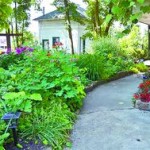First, let’s look at the how and why of proper hot-weather mowing. In the middle of your hottest months, the surface of your closely cropped lawn can easily climb two dozen degrees above the outdoor air temperature. Heat is a killer. So is moisture loss, which occurs when you cut the lawn too frequently during high temperatures. Heat-stressed, dry lawns are extremely susceptible to insects, spotting, weeds, and root disease as they try to heal from literally being scalped.
Properly mowed lawns, on the other hand, retain moisture, fostering deeper root growth, and the healthy blades of grass produce more of the nutrients necessary for your lawn to thrive in difficult conditions.
Sharpen Your Mower Blades, and Your Technique
Sharp blades cut–not shred–your grass. It’s important to realize that mowing actually creates a routine lawn injury. Minimize damage by using sharp blades and mowing in cooler morning or evening hours–but only when the lawn is dry. In summer months, you may have to mow more frequently, but always mow at a higher cut. If you’re cutting more than 1/3 of the total height of the grass, you’re scalping it.
Here are some suggested mowing heights based on your grass type:
- Fine fescue: 2 1/2″-3 1/2″
- Zoysiagrass: 1/2″-1″
- Kentucky bluegrass: 2 1/2″-3″
- St. Augustine grass: 3″-3 1/2″
- Centipede grass: 1-1 1/2″
- Tall fescue: 2 1/2″-3 1/2″
- Perennial Ryegrass: 2 1/2″-3″
- Bermuda grass: 1/2″-1″
- Zoysiagrass: 1/2″-1″
Technorati Tags: lawns, Mower Blades, Technique

